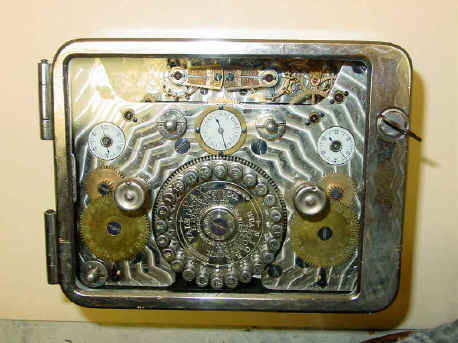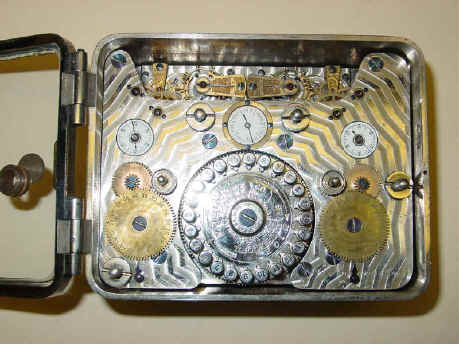Yale & Towne Manufacturing Co., Stamford, Connecticut - Single Pin Dial prototype compared to production model All left hand photos are those of the Yale Single Pin Dial prototype with the production model on the right.
The door is designed to hide movement on the left, while the opposite is true on the production model as well as all other Yale pin dial models. Also note the lack of any manufacturer's as well as patent data on the pin dial. All production models of Yale's as well as most all other time lock makers were careful to be sure such patent data was prominently displayed due to the litigious nature of the industry.
Some of the indicator dials and wheels which were present on the production model are missing on the prototype. The dual 60 minute indicators, as well as the dual hour duration wheels which are connected to the winding arbor and tell the operator how many hours are left until the lock goes off guard are gone. The latter looking to be replaced with curious wheels that are divided into eight sectors numbered one through eight. The front movement plate is split horizontally just above the day-of-week dial on the prototype, as well as vertically; centered on the pin dial axis (four plates). The production model had only the vertical split.
The prototype movement plate is devoid of any identifying markings other than the number 2 stamped on the top plate edge. Production models were numbered and signed by the movement maker E. Howard on the front face plate, this being #444. The prototype uses a couple of much smaller platform escapements containing overall thinner, less robust, solid rimmed balance wheels and lacking bimetallic temperature compensation. Larger, better made escapements with compensation were included in the production model.
The rear shows a very different layout of the intra-day release lever for the bolt dog.
The release levers on the prototype are completely independent of each other and each operate directly on the bolt dog. On the production model the long pin engages the bolt dog and continues backward through the lever nearest the viewer and across a recess above the lever behind. The nearest lever is released by the intra-day works, from one to 72 hours; the one behind by the inter-day works, Monday through Sunday. In this way, if the rear lever is released (lowered) the dog is not if the nearest lever is still raised, however if the nearest lever is released (lowered) it cannot release the dog if the rear lever is still engaged (upper position) which would occur during the weekend preventing the safe from accidentally being unprotected during the weekend.
The case on the prototype lacked Yale's spring suspension system. This was already developed on their earlier Double Pin Dial model and was incorporated into their production models. One can see the long mounting pins in the case on the right with the lower spring set. Once the movement was in place another set of four springs would be placed onto the pins and secured with nuts, thus keeping the rear movement plate secured between the springs. This was to ameliorate the effects of impacts from jackhammer blows or explosion, although no time lock company ever guaranteed failure from a large explosion. Lastly, notice the difference of the number of mounting holes between the prototype and the production version. It is very unlikely that a lock destined for commercial use would have been mounted to the safe door with only two bolts.
The suspension system resulted in a deeper case of 3.25" as opposed to 2.5"on the prototype. Yale Model No: 2, prototype c.1883. Single Pin Dial Time lock. This lock was used as a test bed to determine the practicality of Yale using a single pin dial arrangement, yet driven by two separate movements in order to achieve the smaller area necessary for the lock to occupy on smaller safe doors as opposed to their Model #1, the Double Pin Dial which needed a larger footprint. At the time Sargent & Greenleaf's Model 4 and Consolidated Time Lock had competing small format time locks. Other examples of two movements controlled by one dial are Beard & Brothers Type 2 and Mosler's first time lock. Case unnumbered, Movement #2. file 130 A feature unique to this type of time lock (pin dial) is that as well as being ' off guard ' it can go ' on guard ' in accordance with the settings of the pins. As such it is designed to run continuously, unlike the majority of time locks which go off guard when they run down. However, if the movements are allowed to stop completely they will take the lock off guard, despite the settings of the pins. |

